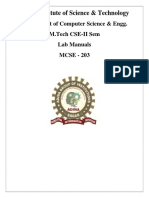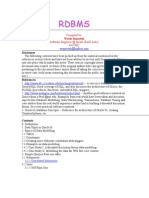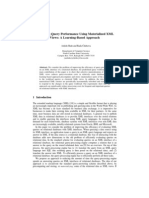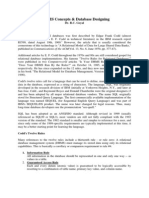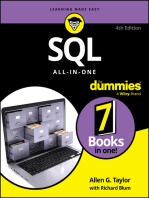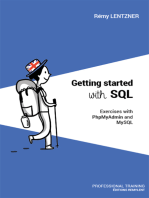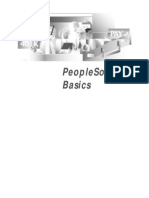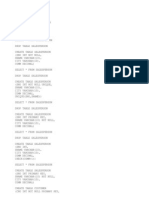A Wiki For Business Rules in Open Vocabulary Executable English
A Wiki For Business Rules in Open Vocabulary Executable English
Uploaded by
Ouafae ElkasriCopyright:
Available Formats
A Wiki For Business Rules in Open Vocabulary Executable English
A Wiki For Business Rules in Open Vocabulary Executable English
Uploaded by
Ouafae ElkasriOriginal Title
Copyright
Available Formats
Share this document
Did you find this document useful?
Is this content inappropriate?
Copyright:
Available Formats
A Wiki For Business Rules in Open Vocabulary Executable English
A Wiki For Business Rules in Open Vocabulary Executable English
Uploaded by
Ouafae ElkasriCopyright:
Available Formats
A Wiki for Business Rules in Open Vocabulary, Executable English
Adrian Walker
Reengineering Bristol, CT 06011-1412, USA internet.business.logic@gmail.com
Abstract The problem of business-IT alignment is of widespread economic concern. As one way of addressing the problem, this paper describes an online system that functions as a kind of Wiki -- one that supports the collaborative writing and running of business and scientific applications, as rules in open vocabulary, executable English, using a browser. Since the rules are in English, they are indexed by Google and other search engines. This is useful when looking for rules for a task that one has in mind. The design of the system integrates the semantics of data, with a semantics of an inference method, and also with the meanings of English sentences. As such, the system has functionality that may be useful for the Rules, Logic, Proof and Trust requirements of the Semantic Web. The system accepts rules, and small numbers of facts, typed or copy-pasted directly into a browser. One can then run the rules, again using a browser. For larger amounts of data, the system uses information in the rules to automatically generate and run SQL over networked databases. From a few highly declarative rules, the system typically generates SQL that would be too complicated to write reliably by hand. However, the system can explain its results in step-by-step hypertexted English, at the business or scientific level As befits a Wiki, shared use of the system is free. Introduction The well known "layer cake" diagram (Berners-Lee 2004) outlines a high level agenda for work on the Semantic Web.
Figure 1. The Semantic Web Layer Cake
There is much current work in progress under the heading of "Semantics", as in the interleaving of metadata with data in RDF or OWL, stemming from (Berners-Lee et al, 2001). Such work fits into the layers from XML to Ontology in Figure 1. It may be useful to think of this as "data semantics", or "Semantics1". In the diagram, there are boxes labeled Rule, Unifying Logic, Proof and Trust, User Interface and Applications. This paper describes one way of meeting some of the requirements indicated by those boxes, with an online system that combines Semantics1 with two further kinds of meaning. Semantics2 specifies what conclusions a reasoning engine should be able to infer from any set of rules and facts (Walker 1993), using a logical model theory (Apt et al 1988) that takes into account the semantics under which databases are used in practice. Semantics3 concerns the meaning of English concepts at the author- and user-interface. The design of the system described here rests on making Semantics1, 2, and 3 work together. Adding and integrating these semantic dimensions has the potential not only to support aspects of the Semantic Web, but also to ease some significant problems in commercial IT. According to (Forrester 2005) : Aligning IT strategy with business strategy has been one of the top three issues confronting IT and business executives for more than 20 years. Polling of CIOs and business executives conducted in 2004 revealed that aligning IT and business goals remains their No. 1 or 2 priority. As one way of addressing the problem, this paper shows how to support the writing and running of applications as rules in open vocabulary, executable English. The system that does this takes a lightweight approach to English, backed by an inference engine that assigns a highly declarative meaning to a set of rules. The system accepts rules in English, and small numbers of RDF or relational facts, typed or copy-pasted directly into a browser. For larger amounts of data, the system uses information in the rules to automatically generate and run SQL over networked databases. From a few rules, the system typically generates SQL that would be too complicated to write reliably by hand. However, the system can explain its results in step-by-step hypertexted English, at the business or scientific level. From the point of view of a person writing and running rules, the system is simply a browser, used actively rather than for passive browsing. Thus, the system functions as a kind of Wiki for executable English content. Here are some examples.
A Semantic Resolution Example The paper (Peng et al 2002) describes an example of name resolution for e-commerce, using three namespaces: retailer, manufacturer, and shared. In the example, a retailer orders computers from a manufacturer. However, in the retailer's terminology, a computer is called a PC for Gamers, while in the manufacturer's terminology, it is called a Prof Desktop.
Fortunately, the retailer and the manufacturer can agree that both belong to the class of Workstations/Desktops. We also find out to what extent a Prof Desktop has the required memory, CPU and so forth for a PC for Gamers. One of the rules for this is shown in Figure 2.
for the retailer the term some-item1 has super-class some-class in the some-ns namespace for the manufacturer the term some-item2 has super-class that-class in the that-ns namespace ----------------------------------------------------------------------------------------------------------------------the retailer term that-item1 and the manufacturer term that-item2 agree - they are of type that-class
Figure 2. A Rule for Semantic Resolution The rule says that, if the two premises above the line are true, then so is the conclusion. In the rule, "some-item1", "that-class" and so on are place holders, or variables, that will be filled in with actual values, such as "PC for Gamers" and "Computers" when the rule is run. Apart from the place holders, the rest of the words in the rule are in open vocabulary, open syntax, English. So, the rule defines the meaning of the last sentence in terms of the meanings of the first two. To avoid infinite regress, this process stops at the headings of data tables. The headings are similar sentences, and the number of place holders in a heading is the number of columns in the table. To view and run the example, one can point a browser to (Reeng 2006) and select SemanticResolution1.
An RDF Query Example The paper (Haase et al 2004) describes a use case in which 14 test questions are put to some RDF data about published papers and their authors. The paper describes several Semantic Web query languages, and shows that none of those languages can answer all 14 questions. It is straightforward to write rules that allow the system to answer all 14 questions. One such rule is shown in Figure 3.
some-paper is related by fact#:title to some-title that-paper is related by fact#:author to some-description that-description is related by some-rdf-node to some-home-page that-home-page is related by fact#:name to some-name that-home-page is related by fact#:email to some-email ------------------------------------------------------------------------------that-name is an author , with email that-email , of that-title
Figure 3. A Rule for the RDF Query Example
Reasoning over RDF, even in this relatively simple example, is quite hard for a person to follow. A nontechnical user, who was unsure whether to trust an answer, would have a hard time convincing himself of its validity simply by looking at the rules and the RDF data, and would probably find it impossible to do so with a SQL-like query language. To help with this matter of trust, the system can supply a step-by-step English explanation of any answer that it produces. It can also explain in English why it failed to give an expected answer. The answer to a request such as "show me the authors of papers and their email addresses" is a table saying that, amongst others, Jeen Broekstra is an author , with email jbroeks@cs.vu.nl , of RDF Query Languages. A step in an explanation is shown in Figure 4.
Paper is related by fact#:title to An Overview of RDF Query Languages Paper is related by fact#:author to __Description1 __Description1 is related by rdf:_1 to http://www.cs.vu.nl/~jbroeks/ http://www.cs.vu.nl/~jbroeks/ is related by fact#:name to Jeen Broekstra http://www.cs.vu.nl/~jbroeks/ is related by fact#:email to jbroeks@cs.vu.nl --------------------------------------------------------------------------------------------------------Jeen Broekstra is an author , with email jbroeks@cs.vu.nl , of RDF Query Languages
Figure 4. An Explanation Step in the RDF Query Example On the other hand, if we ask whether Adrian Walker is the author of the paper, we get a No answer, and a step in the explanation is similar to Figure 4, except that the last two premises are marked as missing, and the conclusion is marked not shown. An explanation always starts out with the general justification of an answer, and provides hyperlinks so that one can drill down into more detail as needed. In particular, we could write additional rules so that a rather technical, RDF-based explanation step is preceded by something more suitable for an end user to read. To view and run the example, one can point a browser to (Reeng 2006) and select RDFQueryLangComparison1.
An OWL Inferencing Test Example The W3C provides a number of test cases for OWL (W3C 2004). One of these requires the inference that the items in a list are different if they are of rdf:type owl:AllDifferent. One of the rules for this task is shown in Figure 5.
some-tag is related by rdf:type to owl:AllDifferent that-tag is related by owl:distinctMembers to some-start-tag from that-start-tag we can follow a list to some-item that-item is related by rdf:type to some-type ----------------------------------------------------------------------------------------------------that-tag names a collection of distinct items of type that-type that includes that-item
Figure 5. A Rule for the OWL Inferencing Example To view and run the example, one can point a browser to (Reeng 2006) and select OwlTest1.
An Oil Industry Supply Chain Example When a geographic region has a demand for a quantity of an oil product, it is in general possible to meet the demand using a number of equivalent products. Many factors influence the proportions of component products that are combined to make an optimal supply chain decision. The factors include the season of the year, the locations of available equivalent products, and the availability of suitable and timely transportation. For our example (Kowalski and Walker 2005), we project that the target region NJ will need 1000 gallons of product 'y' in October. We then ask what alternative routes and modes-of-transportation (truck, train, boat, pipe) do we have to get that product to the region. Next we ask whether there's a refinery nearby that can produce the base product for finished product 'y'. With all of that, we finally say that we need a delivery plan that is optimized to deliver on time, make a profit, and beat the competition. However, if there is not enough of product 'y', then, depending on the region and the customers, product 'x' or 'z' will do as well; they're just variations of 'y using different additives. But they'll only do just as well in region NJ for the season including October. This makes sales projections and marketing more complicated, but also gives us more competitive flexibility. One of the rules for the supply chain task is shown in Figure 6.
Estimated demand some-id in some-region is for some-quantity gallons of some-finished-product in some-month of some-year for demand that-id for that-finished-product refinery some-refinery can supply some-amount gallons of some-product for demand that-id the refineries have altogether some-total gallons of acceptable base products that-amount / that-total = some-long-fraction that-long-fraction rounded to 2 places after the decimal point is some-fraction --------------------------------------------------------------------------------------------------------------------------------------------for estimated demand that-id that-fraction of the order will be that-product from that-refinery
Figure 6. A Rule for the Oil Industry Supply Chain Example As of the writing of this paper, typing estimated demand some-id in some-region into Google finds the rules on the world wide web.
Here is a fragment of the SQL that is automatically generated from the rules: select distinct x6,T2.PRODUCT,T1.NAME,T2.AMOUNT,x5 from T6 tt1,T6 tt2,T5,T4,T3,T2,T1,T6, (select x3 x6,T6.FINISHED_PRODUCT x7,T6.ID x8,tt1.ID x9,tt2.ID x10,sum(x4) x5 from T6,T6 tt1,T6 tt2, ((select T6.ID x3,T3.PRODUCT1,T1.NAME,T2.AMOUNT x4,T2.PRODUCT from T1,T2,T3,T4,T5,T6,T6 tt1,T6 tt2 where T1.NAME=T2.NAME and T1.REGION=T6.REGION and T2.MONTH1=T4.MONTH1 and T2.MONTH1=T6.MONTH1 and T2.PRODUCT=T3.PRODUCT2 and T4.MONTH1=T6.MONTH1 and T3.PRODUCT1=T6.FINISHED_PRODUCT and T3.SEASON=T4.SEASON and T3.SEASON=T5.SEASON and T4.SEASON=T5.SEASON and T6.ID=tt1.ID and T6.ID=tt2.ID and tt1.ID=tt2.ID) union .... It would be difficult to write such SQL reliably by hand, or to manually validate a result that the system has found. As a way of establishing trust, the system can explain each result in step-by-step, hypertexted English, at the business or scientific level. To view and run the example, one can point a browser to (Reeng 2006) and select Oil-IndustrySupplyChain1.
A Bioinformatics Ontology Example The paper (Smith et al 2005) describes a way of assigning a formal meaning to relations in bioinformatics ontologies. For example, the paper defines what it means for a continuant class to be a part of another class, in terms of some easily understood primitive relations and some reasoning over time. If C and C1 are classes, then the paper defines C part_of C1 = [definition] for all c, t, if Cct then there is some c1 such that C1c1t and c part_of c1 at t where Cct is shorthand for "c is an instance of C at time t" Figure 7 shows some of the rules that make this definition executable over ground data.
for all c, t, if some-C c t then there is some c1 such that some-C1 c1 t and c part_of c1 at t -----------------------------------------------------------------------------------------------------------that-C is a part_of the continuant class that-C1
(A c,t) [ some-C c t => (E c1) [ some-C1 c1 t and c part_of c1 at t ] ] -------------------------------------------------------------------------------------------------------for all c, t, if that-C c t then there is some c1 such that that-C1 c1 t and c part_of c1 at t
some-C and some-C1 are two different Non-process classes with instances not : (E c,t) [ that-C c t and not (E c1) [ that-C1 c1 t and c part_of c1 at t ] ] ------------------------------------------------------------------------------------------(A c,t) [ that-C c t => (E c1) [ that-C1 c1 t and c part_of c1 at t ] ]
Figure 7. Some Rules for the Bioinformatics Ontology Example To view and run the example, one can point a browser to (Reeng 2006) and select RelBioOntDefn3.
System Design In any system designed to answer English questions, we need a way of showing users what kinds of questions can reasonably be asked. If we load some oil industry rules into the system, we do not want a user to ask about bioinformatics ontologies. The current system guides a user by showing a menu consisting of generalized versions of the sentences that were used in writing the rules for a particular task. At the top of the menu, the system shows a group of sentences that are not used as premises in any rules. These correspond to generalized versions of the most important questions that the application can answer. Next, the system shows sentences that were used as premises for the top group, and so on. A user can select a sentence directly from the menu. Alternatively, she can type in an arbitrary English sentence, in which case the system will use a form of conventional information retrieval to bring relevant rule conclusions to the top of the menu. Once a user has selected a generalized sentence to use as a question, she can specialize it using automatically generated submenus. This can be done by replacing "some-name" with "Fred", or making a range restriction, or asking for an approximate match. For a person writing rules, the vocabulary is open, and so, to a large extent, is the English syntax. In contrast to most natural language systems, there is no dictionary or grammar of English to be maintained. As such, the support for English is lightweight, but this has a practical advantage -someone writing rules can freely use jargon, acronyms, words not in any dictionary, ungrammatical
sentences, mathematical notations and so on. The price for this is, if an author wishes the system to regard two sentences as the same, she must write rules that say so. An advantage is that the English semantics are strict a sentence means exactly what it says (in context), and nothing else. Although the vocabulary is open as far as the system is concerned, one can write a collection of rules and facts that defines a controlled vocabulary. While there is no dictionary or grammar of English, the system does contain a grammar that recognizes rules and tables of data. So, if an author types in a simple rule that does not consist of one or more sentences, followed by an underline, followed by a single sentence, the system responds with a warning. Also, the underlying rule syntax requires that each place holder (or variable) that appears in a conclusion of a rule should also appear in simple premise of the same rule. Similarly, if a sentence is negated (as in the Bioinformatics Ontology Example), the system requires that each of the variables in the sentence should be mentioned in earlier simple premises. There is further checking to ensure that it is not possible for the conclusion of a rule to depend on a negation of itself, even if that happens through a chain of other rules. Should that happen, the system shows the rules concerned, together with a warning. The lightweight English -- Semantics3 -- is supported by an inference method that assigns a strongly non-procedural meaning to the rules -- Semantics2 -- (Apt et al 1988). The inference method used is based on that in (Walker 1993). The method switches automatically between forward and backward execution of the rules. The non-procedural approach is necessary, because an English sentence must keep the same declarative meaning regardless of where it appears sequentially in a collection of rules, and regardless of changes to rules in which the sentence does not appear. For authors who are not programmers, this approach has the advantage that the answers one gets from a set of rules and facts do not depend on the textual sequence in which the rules appear. This is in contrast to a procedural reading, in which a collection of N rules potentially has factorial(N) different meanings, corresponding to different permutations of the rule sequence.
Conclusions I have described a design that combines semantics for data, for inference, and for English. There is an online system for this -- a kind of Wiki for rules in open vocabulary, executable English. When the rules are run, the system can explain its results (and also why expected results are missing), in hypertexted English at the business or scientific level. The system can also automatically generate and run SQL over networked databases. The generated SQL can be too complex to write reliably by hand, but its results can also be explained in English. The author- and user-interface of the system is simply a browser, and shared use of the system is free. Since the rules are in English, they are indexed by Google and other search engines. This is useful when looking for rules for a task that one has in mind.
The approach used in the system has the potential to address some of the requirements for Rules, Logic, Proof and Trust that are outlined in the upper levels of the Semantic Web layer cake diagram: Rules and Logic via highly declarative inferencing; Proof and Trust via English explanations. Similarly, there is the potential for the approach to address the significant economic problem of business-IT alignment.
References Apt, Krzysztof R.; Howard A. Blair, and Adrian Walker. Towards a theory of declarative knowledge. In Jack Minker, editor, Foundations of Deductive Databases and Logic Programming, pages 89--148. Morgan Kaufmann, Los Altos, CA, 1988. Berners-Lee, T. 2004. www.w3.org/2004/Talks/0412-RDF-functions/slide4-0.html. See also update at http://www.w3.org/2007/03/layerCake.png Berners-Lee, T; J. Hendler, O. Lassila. 2001. The Semantic Web, Scientific American, May 2001, pp. 28-37. Forrester 2005. "IT and Business Alignment: Are we there Yet?", Forrester Research Report, www.forrester.com. Haase, Peter; Jeen Broekstra, Andreas Eberhart, and Raphael Volz. 2004. A Comparison of RDF Query Languages. Proceedings of the Third International Semantic Web Conference, Hiroshima, Japan. Also, www.aifb.uni-karlsruhe.de/WBS/pha/rdf-query/rdfquery.pdf . Kowalski, Ted and Adrian Walker. 2005. Oil Industry Supply Chain Management Using English Business Rules Over SQL. www.reengineeringllc.com/Oil_Industry_Supply_Chain_by_Kowalski_and_Walker.pdf Peng, Y; Youyong Zou, Xiaocheng Luan, Nenad Ivezic, Michael Gruninger and Albert Jones. 2002. Semantic Resolution for E-Commerce. www.mel.nist.gov/msidlibrary/doc/semantic.pdf Reeng 2006. www.reengineeringllc.com . Smith, Barry; Werner Ceusters, Bert Klagges, Jacob Khler, Anand Kumar, Jane Lomax, Chris Mungall, Fabian Neuhaus, Alan L Rector and Cornelius Rosse. 2005. Relations in Biomedical Ontologies. Genome Biology. http://genomebiology.com/2005/6/5/R46 W3C 2004. OWL Web Ontology Language Test Cases. W3C Recommendation. www.w3.org/TR/owl-test/byFunction#function-AllDifferent Walker, A. 1993. Backchain Iteration: Towards a Practical Inference Method that is Simple Enough to be Proved Terminating, Sound and Complete. Journal of Automated Reasoning, 11:1-2
V200807
You might also like
- Regular Expressions and Its ApplicationsDocument6 pagesRegular Expressions and Its ApplicationsAminaNo ratings yet
- Efficient Searching On Data Using Forward SearchDocument8 pagesEfficient Searching On Data Using Forward SearchInternational Journal of Application or Innovation in Engineering & ManagementNo ratings yet
- Relational Databases For Querying XML Documents Limitations and OpportunitiesDocument13 pagesRelational Databases For Querying XML Documents Limitations and Opportunitiesphuc2009No ratings yet
- Oracle For BeginnersDocument78 pagesOracle For BeginnersAhmad Abba100% (2)
- Module 2 Units 3 & 4 Review QuestionsDocument4 pagesModule 2 Units 3 & 4 Review QuestionsAlexander BaxterNo ratings yet
- Adina Institute of Science & Technology: Department of Computer Science & Engg. M.Tech CSE-II Sem Lab Manuals MCSE - 203Document22 pagesAdina Institute of Science & Technology: Department of Computer Science & Engg. M.Tech CSE-II Sem Lab Manuals MCSE - 203rajneesh pachouriNo ratings yet
- The Extensible Markup LanguageDocument6 pagesThe Extensible Markup LanguageJennetNo ratings yet
- Template Extraction From Heterogeneous Web Pages Using Text ClusteringDocument6 pagesTemplate Extraction From Heterogeneous Web Pages Using Text Clusteringsurendiran123No ratings yet
- RDBMS PDFDocument10 pagesRDBMS PDFRupesh PatraNo ratings yet
- 4.1 Semantic Data and Web: Unit 4 OntologyDocument12 pages4.1 Semantic Data and Web: Unit 4 OntologyZarana KananiNo ratings yet
- Supporting Search-As-You-Type Using SQL in Databases: Guoliang Li, Jianhua Feng, Member, IEEE, and Chen Li, Member, IEEEDocument15 pagesSupporting Search-As-You-Type Using SQL in Databases: Guoliang Li, Jianhua Feng, Member, IEEE, and Chen Li, Member, IEEEAjay TaradeNo ratings yet
- RDF Integration in HTML 5 Web Pages: Gijs Davis G.davis@student - Utwente.nlDocument8 pagesRDF Integration in HTML 5 Web Pages: Gijs Davis G.davis@student - Utwente.nlkuvvarapuanilkumarNo ratings yet
- SQL NotesDocument62 pagesSQL NotesWatsh Rajneesh100% (9)
- QA Review: IR-based Question AnsweringDocument11 pagesQA Review: IR-based Question AnsweringTeklit BerihuNo ratings yet
- Semantic Web Road MapDocument10 pagesSemantic Web Road MapBhakthi KrupaNo ratings yet
- XML - Inerview - QuestionsDocument3 pagesXML - Inerview - Questionssrikrishna007No ratings yet
- Authors:: XML Query and Transformation LanguageDocument3 pagesAuthors:: XML Query and Transformation Languageऋतिक राज़No ratings yet
- Web Development Services Arslan RajpootDocument7 pagesWeb Development Services Arslan Rajpootarslanrajpoot3067No ratings yet
- Basic Database Performance Tuning - Developer's Perspective: Michal KwiatekDocument6 pagesBasic Database Performance Tuning - Developer's Perspective: Michal KwiatekMohd YasinNo ratings yet
- XML Programming With SQL/XML and Xquery: Facto Standard For Retrieving and ExchangingDocument24 pagesXML Programming With SQL/XML and Xquery: Facto Standard For Retrieving and ExchangingdkovacevNo ratings yet
- RDBMS ConceptsDocument73 pagesRDBMS ConceptsMinaxi Mantri100% (1)
- Oracle SQL Revealed: Executing Business Logic in the Database EngineFrom EverandOracle SQL Revealed: Executing Business Logic in the Database EngineNo ratings yet
- Roy Fielding Rest ThesisDocument6 pagesRoy Fielding Rest Thesisjmvnqiikd100% (2)
- Semantic Web DissertationDocument4 pagesSemantic Web DissertationCanYouWriteMyPaperForMeUK100% (1)
- Application DataDocument120 pagesApplication DataEyobNo ratings yet
- Paper 6 WeiskeDocument12 pagesPaper 6 WeiskeJulio René López GuerreroNo ratings yet
- TNTRB Data Structure WWW - Governmentexams.co - inDocument121 pagesTNTRB Data Structure WWW - Governmentexams.co - inkaniNo ratings yet
- PHD Thesis Template Word 2010 UkDocument6 pagesPHD Thesis Template Word 2010 UkWriteMyPaperForMeSpringfield100% (2)
- Chapter 1: Introduction: Efficient Search in Large Textual Collections With Redundancy - 2009Document31 pagesChapter 1: Introduction: Efficient Search in Large Textual Collections With Redundancy - 2009tibinttNo ratings yet
- SQL Query Tuning For OracleDocument17 pagesSQL Query Tuning For Oracledorapoli6650% (2)
- Fine-Tuning of Small/Medium LLMs For Business QA On Structured DataDocument17 pagesFine-Tuning of Small/Medium LLMs For Business QA On Structured DataDarrenNo ratings yet
- XML Interview QuestionsDocument6 pagesXML Interview QuestionsdskishoreNo ratings yet
- Solving Ordinary Differential Equations Using TaylDocument15 pagesSolving Ordinary Differential Equations Using TaylAyesha MalikNo ratings yet
- Improving Query Performance Using Materialized XML Views: A Learning-Based ApproachDocument12 pagesImproving Query Performance Using Materialized XML Views: A Learning-Based ApproachnithiananthiNo ratings yet
- Exploring Semantic Web Modeling Approaches For Web Application DesignDocument14 pagesExploring Semantic Web Modeling Approaches For Web Application Designanumano2004No ratings yet
- Ans: A: 1. Describe The Following: Dimensional ModelDocument8 pagesAns: A: 1. Describe The Following: Dimensional ModelAnil KumarNo ratings yet
- Combining Rules and Ontologies With Carneades: Thomas F. GordonDocument8 pagesCombining Rules and Ontologies With Carneades: Thomas F. GordonumityilmazNo ratings yet
- Annotating Search ResultsDocument14 pagesAnnotating Search ResultsSujaysujuNo ratings yet
- RDBMS Concepts & Database Designing: Dr. R.C. GoyalDocument0 pagesRDBMS Concepts & Database Designing: Dr. R.C. GoyalBalaji RamasubbuNo ratings yet
- Relational Databases For Querying XML DocumentsDocument14 pagesRelational Databases For Querying XML DocumentsH-KatiNo ratings yet
- Supporting Rule System Interoperability On The Semantic Web With SWRLDocument15 pagesSupporting Rule System Interoperability On The Semantic Web With SWRLGülten KaraNo ratings yet
- Query Similarities in Various Web DatabasesDocument6 pagesQuery Similarities in Various Web DatabasesseventhsensegroupNo ratings yet
- The Semantic Web An IntroductionDocument23 pagesThe Semantic Web An IntroductionAland MediaNo ratings yet
- SQL Chache POPLDocument21 pagesSQL Chache POPLDavidNo ratings yet
- Ora 11Document3 pagesOra 11lamxung123No ratings yet
- Hierarchical Database Model: What Is RDBMS? Explain Its FeaturesDocument24 pagesHierarchical Database Model: What Is RDBMS? Explain Its FeaturesitxpertsNo ratings yet
- Research PaperDocument4 pagesResearch PaperpremacuteNo ratings yet
- XML Schema Datatypes in RDF and OWLDocument10 pagesXML Schema Datatypes in RDF and OWLVeer Pratap SinghNo ratings yet
- Web Question Answering: Is More Always Better?: Susan Dumais, Michele Banko, Eric Brill, Jimmy Lin, Andrew NGDocument9 pagesWeb Question Answering: Is More Always Better?: Susan Dumais, Michele Banko, Eric Brill, Jimmy Lin, Andrew NGdamien333No ratings yet
- Database Systems - Lec 1 PDFDocument27 pagesDatabase Systems - Lec 1 PDFM I MalikNo ratings yet
- IM Ch03 Relational DB Model Ed12Document36 pagesIM Ch03 Relational DB Model Ed12Chong Fong KimNo ratings yet
- ATFL Assignment 1Document4 pagesATFL Assignment 1Crack TunesNo ratings yet
- Introduction To Microsoft Access: Computer SkillsDocument16 pagesIntroduction To Microsoft Access: Computer SkillsSaqeb ButtNo ratings yet
- Building A Generative AI PlatformDocument26 pagesBuilding A Generative AI PlatformSuresh KumarNo ratings yet
- GETTING STARTED WITH SQL: Exercises with PhpMyAdmin and MySQLFrom EverandGETTING STARTED WITH SQL: Exercises with PhpMyAdmin and MySQLNo ratings yet
- Practical Entity Framework: Database Access for Enterprise ApplicationsFrom EverandPractical Entity Framework: Database Access for Enterprise ApplicationsNo ratings yet
- DATABASE From the conceptual model to the final application in Access, Visual Basic, Pascal, Html and Php: Inside, examples of applications created with Access, Visual Studio, Lazarus and WampFrom EverandDATABASE From the conceptual model to the final application in Access, Visual Basic, Pascal, Html and Php: Inside, examples of applications created with Access, Visual Studio, Lazarus and WampNo ratings yet
- Zuber Resume Aug23Document1 pageZuber Resume Aug23rajendrasNo ratings yet
- SQL MasterclassDocument24 pagesSQL Masterclassrevaldianggara100% (1)
- Oracle Backup Restore UgDocument18 pagesOracle Backup Restore UgNguyễn TrungNo ratings yet
- Enterprise Big Data Framework Guide V1.4 2 PDFDocument121 pagesEnterprise Big Data Framework Guide V1.4 2 PDFJack Chang100% (1)
- Chapter Four: System Design: Werabe University Institute of Technology Department of Information SystemsDocument23 pagesChapter Four: System Design: Werabe University Institute of Technology Department of Information SystemsAli HussenNo ratings yet
- Spanner Google's Globally-Distributed DatabaseDocument14 pagesSpanner Google's Globally-Distributed Databasefmoreira9650No ratings yet
- Connect Power BI To Azure Synapse Serverless SQL PoolDocument7 pagesConnect Power BI To Azure Synapse Serverless SQL PoolValentinNo ratings yet
- BI LIB - Deck - DeepDive - DashboardScorecard - Final - FY10Document9 pagesBI LIB - Deck - DeepDive - DashboardScorecard - Final - FY10winevyNo ratings yet
- Thenewsignofsuccess, Weprovidewhatyouwan: For More Ignou Solved Assignments Please VisitDocument11 pagesThenewsignofsuccess, Weprovidewhatyouwan: For More Ignou Solved Assignments Please Visitvjsahani0% (2)
- MySQL Developer Training Course ContentDocument4 pagesMySQL Developer Training Course Contentsrmishra2006No ratings yet
- Library PPT PresentationDocument11 pagesLibrary PPT PresentationDr. Sankar Kumar Chakrabarty100% (3)
- Hrms Database TablesDocument22 pagesHrms Database TablesRajesh B ShivaramacharNo ratings yet
- Midterm Module 1aDocument14 pagesMidterm Module 1aMa. Lourdes “Ria” VillanuevaNo ratings yet
- 1 1 6 Dr. Ajay M. RavalDocument6 pages1 1 6 Dr. Ajay M. RavalRohit JangraNo ratings yet
- CSI2132 Course ScheduleDocument2 pagesCSI2132 Course ScheduleJustin Lannin-RoyNo ratings yet
- Odimultiplecsvtotabledynamicodi12c 160702115757Document16 pagesOdimultiplecsvtotabledynamicodi12c 160702115757Subhan FazalNo ratings yet
- GISBookDocument138 pagesGISBookFerti NurhawaliahNo ratings yet
- Brockhausen MeDocument6,159 pagesBrockhausen MeConcurceiro DonnerNo ratings yet
- Ex No: Date: K-Means Clustering Using Python: ScatterDocument10 pagesEx No: Date: K-Means Clustering Using Python: ScatterJasmitha BNo ratings yet
- Advantage and Disadvantage SapDocument4 pagesAdvantage and Disadvantage SapBelén Iturralde GómezNo ratings yet
- Fathan Mubina - 185150400111055 - Lat1Document5 pagesFathan Mubina - 185150400111055 - Lat1Fathan MubinaNo ratings yet
- Authorization Multiple Choice QuestionsDocument14 pagesAuthorization Multiple Choice QuestionsMd. AbdullahNo ratings yet
- SQL Program PracticDocument13 pagesSQL Program PracticYatishTamore100% (2)
- Travel SlidesDocument20 pagesTravel SlidesMukesh KumarNo ratings yet
- Ai 9aDocument5 pagesAi 9abharath.jt.11No ratings yet
- IFLA Statement On Open Library DataDocument2 pagesIFLA Statement On Open Library DataGotzila RufoNo ratings yet
- Dbms RecordDocument58 pagesDbms RecordKokila SNo ratings yet
- UGC NET Objective Question in LISDocument168 pagesUGC NET Objective Question in LISDoraswamy Vandavasi100% (6)
- Data Warehousing SOPDocument5 pagesData Warehousing SOPUmer SheikhNo ratings yet
- Power Bi Consulting Company in DubaiDocument5 pagesPower Bi Consulting Company in DubaiEFM SolutionNo ratings yet





